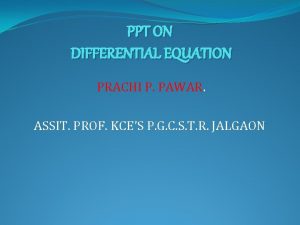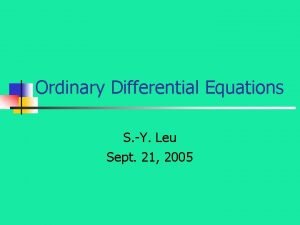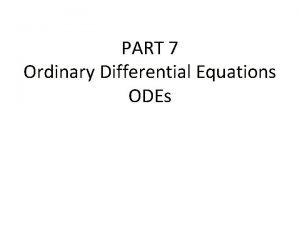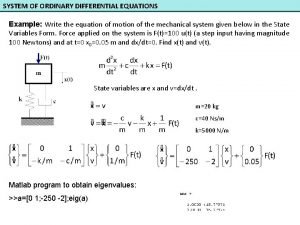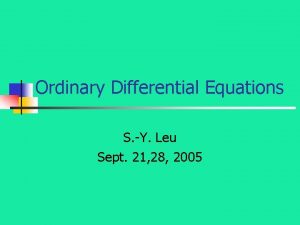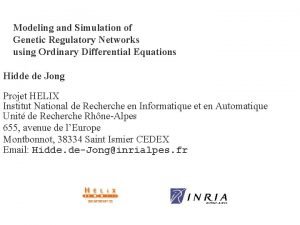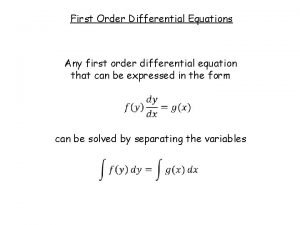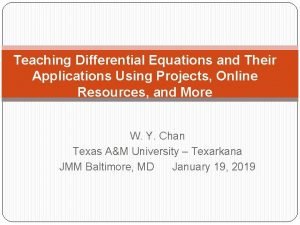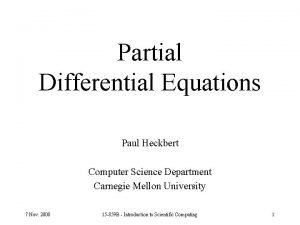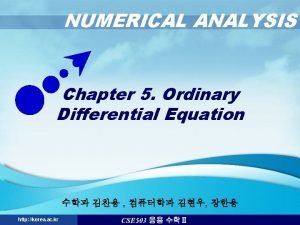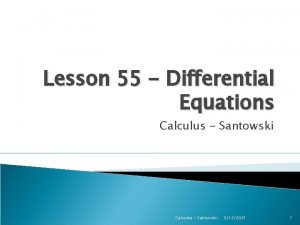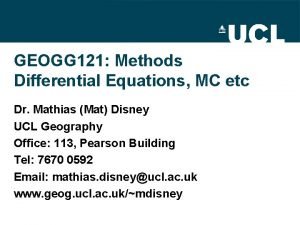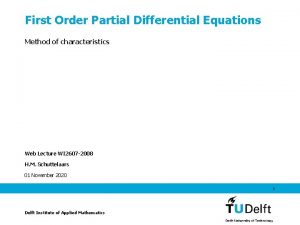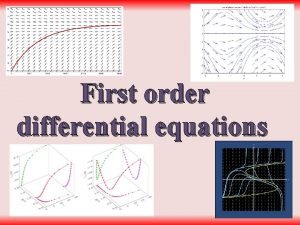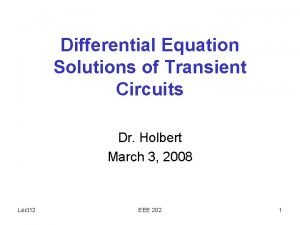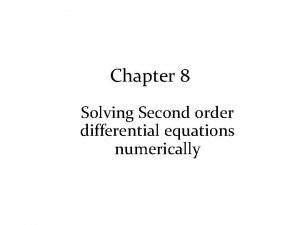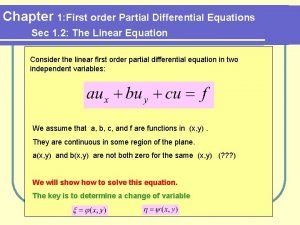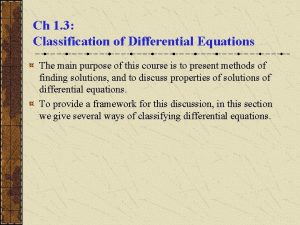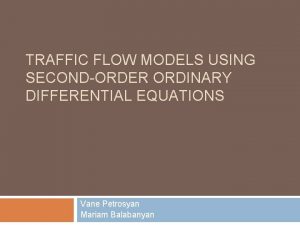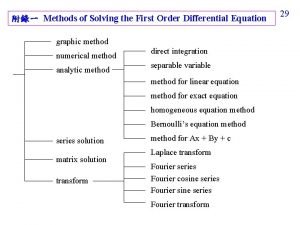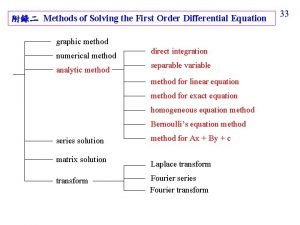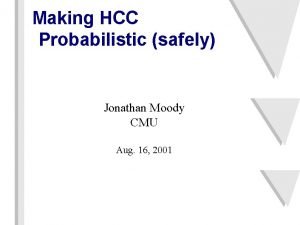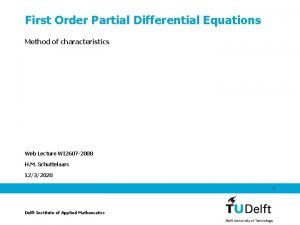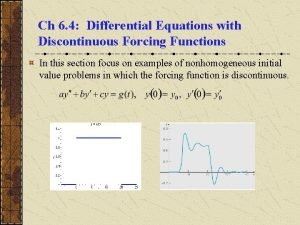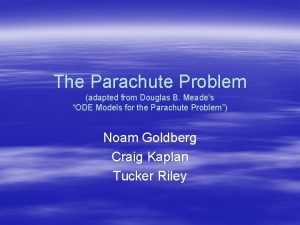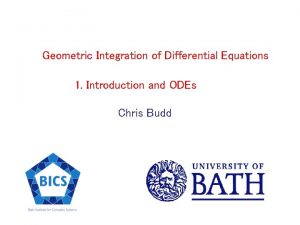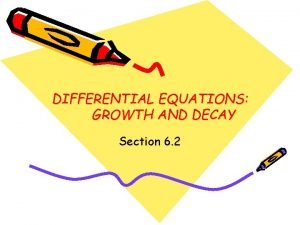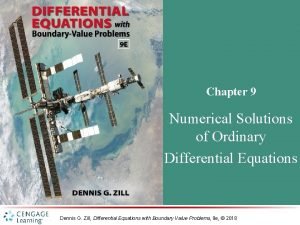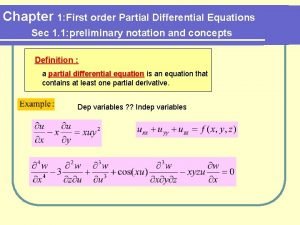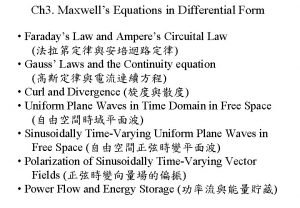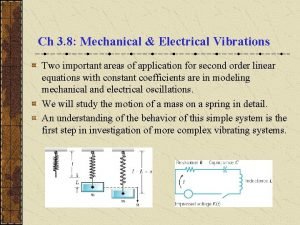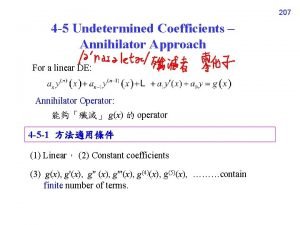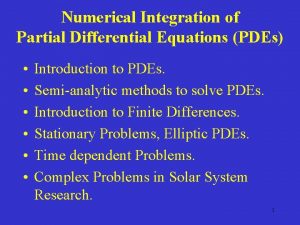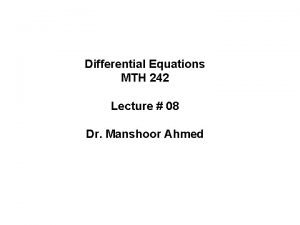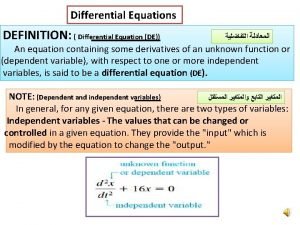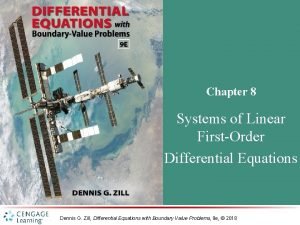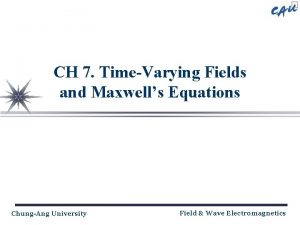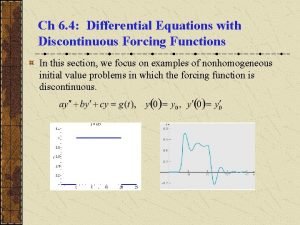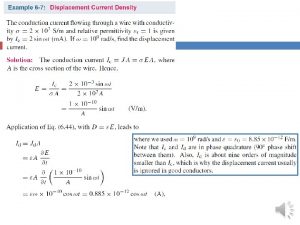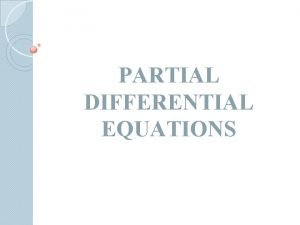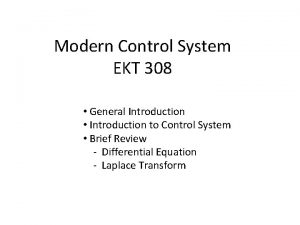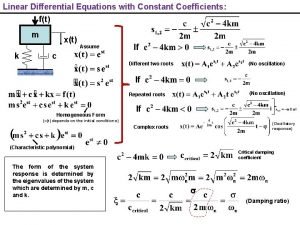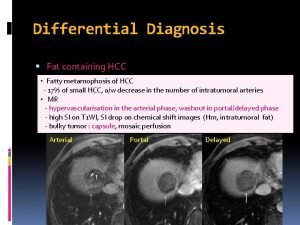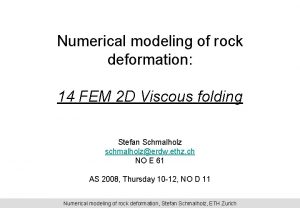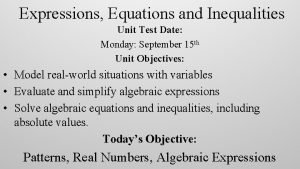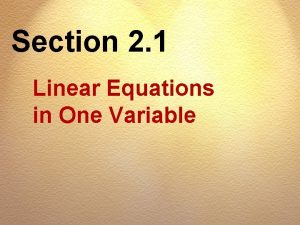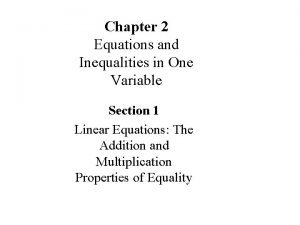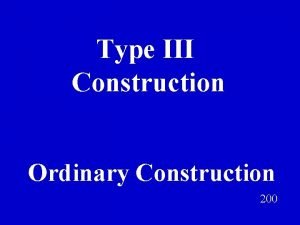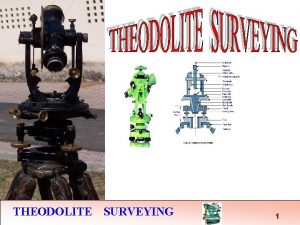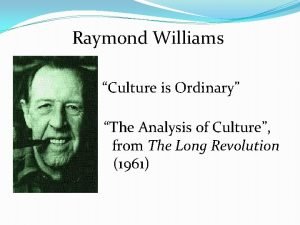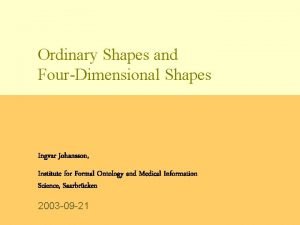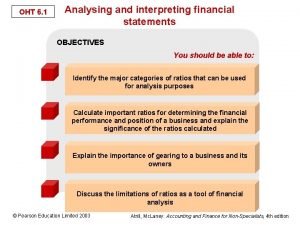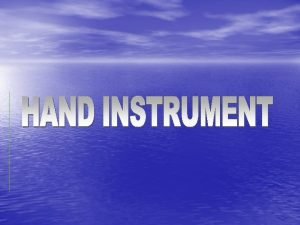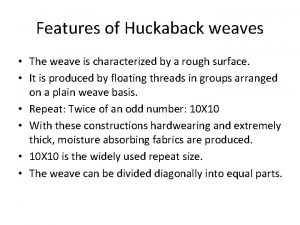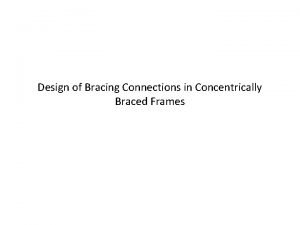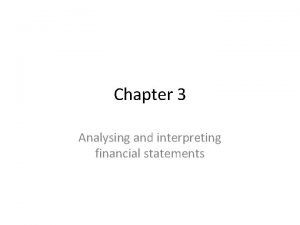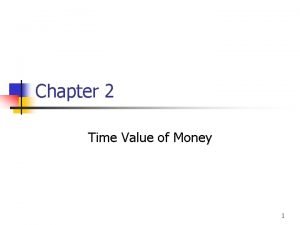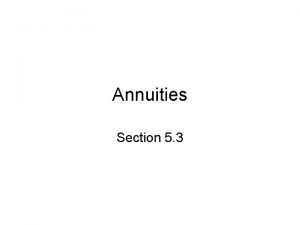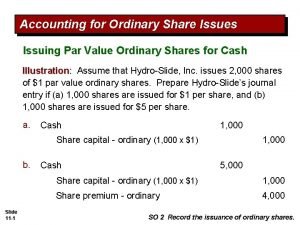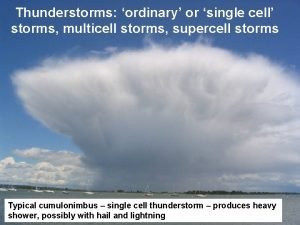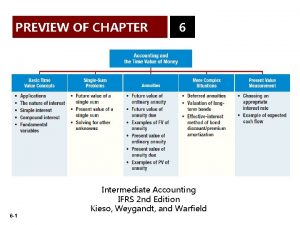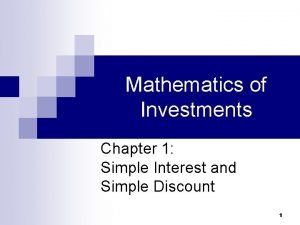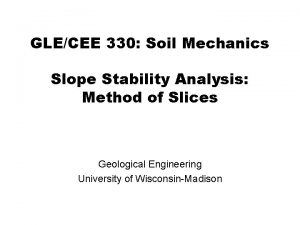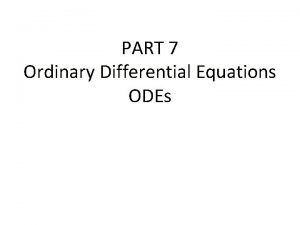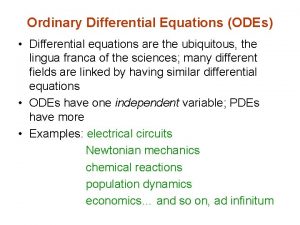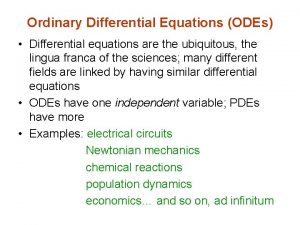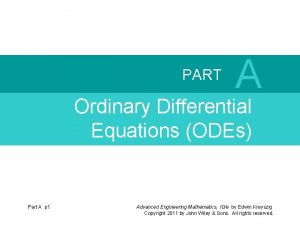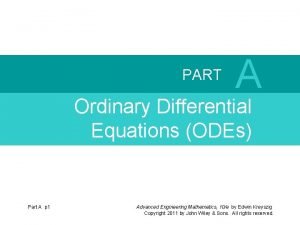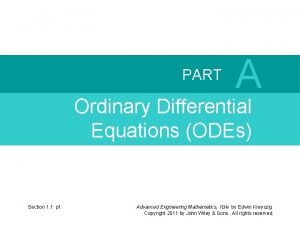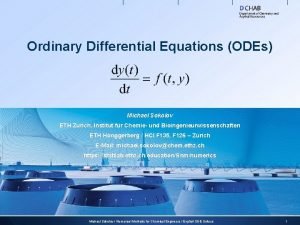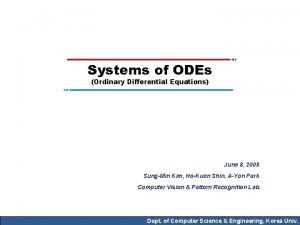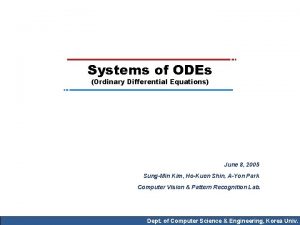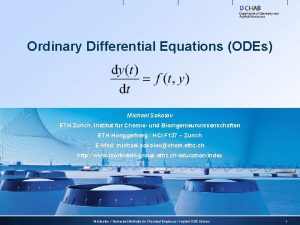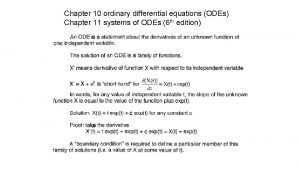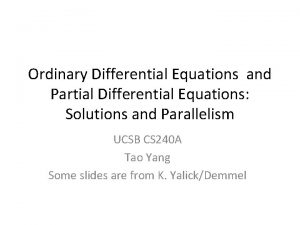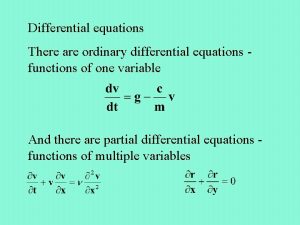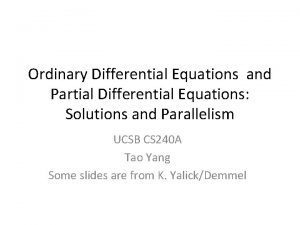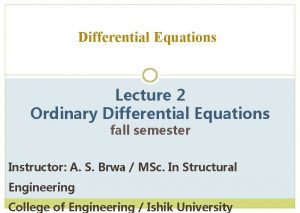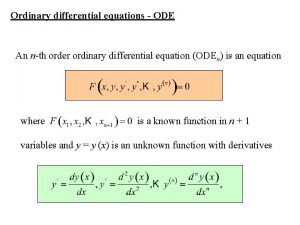PART A Ordinary Differential Equations ODEs Part A




































































![6. 5 Convolution. Integral Equations EXAMPLE 1 Convolution Let H(s) = 1/[(s − a)s]. 6. 5 Convolution. Integral Equations EXAMPLE 1 Convolution Let H(s) = 1/[(s − a)s].](https://slidetodoc.com/presentation_image/0f6322b89b2881006e08aba4c3f84c37/image-69.jpg)






































- Slides: 107

PART A Ordinary Differential Equations (ODEs) Part A p 1 Advanced Engineering Mathematics, 10/e by Edwin Kreyszig Copyright 2011 by John Wiley & Sons. All rights reserved.

CHAPTER 6 Laplace Transforms Chapter 6 p 2 Advanced Engineering Mathematics, 10/e by Edwin Kreyszig Copyright 2011 by John Wiley & Sons. All rights reserved.

6. 0 Laplace Transforms The process of solving an ODE using the Laplace transform method consists of three steps, shown schematically in Fig. 113: Step 1. The given ODE is transformed into an algebraic equation, called the subsidiary equation. Step 2. The subsidiary equation is solved by purely algebraic manipulations. Step 3. The solution in Step 2 is transformed back, resulting in the solution of the given problem. Fig. 113. Solving an IVP by Laplace transforms Chapter 6 p 3 Advanced Engineering Mathematics, 10/e by Edwin Kreyszig Copyright 2011 by John Wiley & Sons. All rights reserved.

6. 0 Laplace Transforms The key motivation for learning about Laplace transforms is that the process of solving an ODE is simplified to an algebraic problem (and transformations). This type of mathematics that converts problems of calculus to algebraic problems is known as operational calculus. The Laplace transform method has two main advantages over the methods discussed in Chaps. 1– 4: I. Problems are solved more directly: Initial value problems are solved without first determining a general solution. Nonhomogenous ODEs are solved without first solving the corresponding homogeneous ODE. II. More importantly, the use of the unit step function (Heaviside function in Sec. 6. 3) and Dirac’s delta (in Sec. 6. 4) make the method particularly powerful for problems with inputs (driving forces) that have discontinuities or represent short impulses or complicated periodic functions. Chapter 6 p 4 Advanced Engineering Mathematics, 10/e by Edwin Kreyszig Copyright 2011 by John Wiley & Sons. All rights reserved.

6. 1 Laplace Transform. Linearity. First Shifting Theorem (s-Shifting) Section 6. 1 p 5 Advanced Engineering Mathematics, 10/e by Edwin Kreyszig Copyright 2011 by John Wiley & Sons. All rights reserved.

6. 1 Laplace Transform. Linearity. First Shifting Theorem (s-Shifting) If f(t) is a function defined for all t ≥ 0, its Laplace transform is the integral of f(t) times e−st from t = 0 to ∞. It is a function of s, say, F(s), and is denoted by L(f); thus (1) Here we must assume that f(t) is such that the integral exists (that is, has some finite value). This assumption is usually satisfied in applications—we shall discuss this near the end of the section. Section 6. 1 p 6 Advanced Engineering Mathematics, 10/e by Edwin Kreyszig Copyright 2011 by John Wiley & Sons. All rights reserved.

6. 1 Laplace Transform. Linearity. First Shifting Theorem (s-Shifting) Not only is the result F(s) called the Laplace transform, but the operation just described, which yields F(s) from a given f(t), is also called the Laplace transform. It is an “integral transform” with “kernel” k(s, t) = e−st. Note that the Laplace transform is called an integral transform because it transforms (changes) a function in one space to a function in another space by a process of integration that involves a kernel. The kernel or kernel function is a function of the variables in the two spaces and defines the integral transform. Section 6. 1 p 7 Advanced Engineering Mathematics, 10/e by Edwin Kreyszig Copyright 2011 by John Wiley & Sons. All rights reserved.

6. 1 Laplace Transform. Linearity. First Shifting Theorem (s-Shifting) Furthermore, the given function f(t) in (1) is called the inverse transform of F(s) and is denoted by L − 1(f); that is, we shall write (1*) f(t) = L − 1(F). Note that (1) and (1*) together imply L − 1(L (f)) = f and L (L − 1(F)) = F. Section 6. 1 p 8 Advanced Engineering Mathematics, 10/e by Edwin Kreyszig Copyright 2011 by John Wiley & Sons. All rights reserved.

6. 1 Laplace Transform. Linearity. First Shifting Theorem (s-Shifting) Notation Original functions depend on t and their transforms on s— keep this in mind! Original functions are denoted by lowercase letters and their transforms by the same letters in capital, so that F(s) denotes the transform of f(t), and Y(s) denotes the transform of y(t), and so on. Section 6. 1 p 9 Advanced Engineering Mathematics, 10/e by Edwin Kreyszig Copyright 2011 by John Wiley & Sons. All rights reserved.

6. 1 Laplace Transform. Linearity. First Shifting Theorem (s-Shifting) Theorem 1 Linearity of the Laplace Transform The Laplace transform is a linear operation; that is, for any functions f(t) and g(t) whose transforms exist and any constants a and b the transform of af(t) + bg(t) exists, and L {af(t) + bg(t)}= a. L {f (t)} + b. L {g(t)}. Section 6. 1 p 10 Advanced Engineering Mathematics, 10/e by Edwin Kreyszig Copyright 2011 by John Wiley & Sons. All rights reserved.

6. 1 Laplace Transform. Linearity. First Shifting Theorem (s-Shifting) Table 6. 1 Some Functions ƒ(t) and Their Laplace Transforms L(ƒ) Section 6. 1 p 11 Advanced Engineering Mathematics, 10/e by Edwin Kreyszig Copyright 2011 by John Wiley & Sons. All rights reserved.

6. 1 Laplace Transform. Linearity. First Shifting Theorem (s-Shifting) s-Shifting: Replacing s by s − a in the Transform The Laplace transform has the very useful property that, if we know the transform of f(t), we can immediately get that of eatf(t), as in Theorem 2. Section 6. 1 p 12 Advanced Engineering Mathematics, 10/e by Edwin Kreyszig Copyright 2011 by John Wiley & Sons. All rights reserved.

6. 1 Laplace Transform. Linearity. First Shifting Theorem (s-Shifting) Theorem 2 First Shifting Theorem, s-Shifting If f(t) has the transform F(s) (where s > k for some k), then eatf(t) has the transform F(s − a) (where s − a > k). In formulas, L {eatf(t)} = F(s − a) or, if we take the inverse on both sides, eatf(t) = L 1{F(s − a)} Section 6. 1 p 13 Advanced Engineering Mathematics, 10/e by Edwin Kreyszig Copyright 2011 by John Wiley & Sons. All rights reserved.

6. 1 Laplace Transform. Linearity. First Shifting Theorem (s-Shifting) Existence and Uniqueness of Laplace Transforms A function f(t) has a Laplace transform if it does not grow too fast, say, if for all t ≥ 0 and some constants M and k it satisfies the “growth restriction” (2) | f(t)| ≤ Mekt. f(t) need not be continuous, but it should not be too bad. The technical term (generally used in mathematics) is piecewise continuity. f(t) is piecewise continuous on a finite interval a ≤ t ≤ b where f is defined, if this interval can be divided into finitely many subintervals in each of which f is continuous and has finite limits as t approaches either endpoint of such a subinterval from the interior. Section 6. 1 p 14 Advanced Engineering Mathematics, 10/e by Edwin Kreyszig Copyright 2011 by John Wiley & Sons. All rights reserved.

6. 1 Laplace Transform. Linearity. First Shifting Theorem (s-Shifting) Existence and Uniqueness of Laplace Transforms (continued) This then gives finite jumps as in Fig. 115 as the only possible discontinuities, but this suffices in most applications, and so does the following theorem. Fig. 115. Example of a piecewise continuous function f(t). (The dots mark the function values at the jumps. ) Section 6. 1 p 15 Advanced Engineering Mathematics, 10/e by Edwin Kreyszig Copyright 2011 by John Wiley & Sons. All rights reserved.

6. 1 Laplace Transform. Linearity. First Shifting Theorem (s-Shifting) Theorem 3 Existence Theorem for Laplace Transforms If f(t) is defined and piecewise continuous on every finite interval on the semi-axis t ≥ 0 and satisfies (2) for all and some constants M and k, then the Laplace transform L (f ) exists for all s > k. Section 6. 1 p 16 Advanced Engineering Mathematics, 10/e by Edwin Kreyszig Copyright 2011 by John Wiley & Sons. All rights reserved.

6. 2 Transforms of Derivatives and Integrals. ODEs Section 6. 2 p 17 Advanced Engineering Mathematics, 10/e by Edwin Kreyszig Copyright 2011 by John Wiley & Sons. All rights reserved.

6. 2 Transforms of Derivatives and Integrals. ODEs The Laplace transform is a method of solving ODEs and initial value problems. The crucial idea is that operations of calculus on functions are replaced by operations of algebra on transforms. Roughly, differentiation of f(t) will correspond to multiplication of L(f) by s (see Theorems 1 and 2) and integration of f(t) to division of L(f) by s. To solve ODEs, we must first consider the Laplace transform of derivatives. You have encountered such an idea in your study of logarithms. Under the application of the natural logarithm, a product of numbers becomes a sum of their logarithms, a division of numbers becomes their difference of logarithms. Section 6. 2 p 18 Advanced Engineering Mathematics, 10/e by Edwin Kreyszig Copyright 2011 by John Wiley & Sons. All rights reserved.

6. 2 Transforms of Derivatives and Integrals. ODEs Theorem 1 Laplace Transform of Derivatives The transforms of the first and second derivatives of f(t) satisfy (1) L( f ’) = s. L(f) − f(0) (2) L(f ”) = s 2 L(f) − sf(0) − f ’(0). Formula (1) holds if f(t) is continuous for all t ≥ 0 and satisfies the growth restriction (2) in Sec. 6. 1 and f ’(t) is piecewise continuous on every finite interval on the semi-axis t ≥ 0. Similarly, (2) holds if f and f ’ are continuous for all t ≥ 0 and satisfy the growth restriction and f ” is piecewise continuous on every finite interval on the semi-axis t ≥ 0. Section 6. 2 p 19 Advanced Engineering Mathematics, 10/e by Edwin Kreyszig Copyright 2011 by John Wiley & Sons. All rights reserved.

6. 2 Transforms of Derivatives and Integrals. ODEs Theorem 2 Laplace Transform of the Derivative f (n) of Any Order Let f, f ’, … , f (n− 1) be continuous for all t ≥ 0 and satisfy the growth restriction (2) in Sec. 6. 1. Furthermore, let f (n) be piecewise continuous on every finite interval on the semi-axis t ≥ 0. Then the transform of f (n) satisfies (3) L(f (n)) = sn L(f) − sn− 1 f(0) − sn− 2 f ’(0) − … − f (n− 1)(0). Section 6. 2 p 20 Advanced Engineering Mathematics, 10/e by Edwin Kreyszig Copyright 2011 by John Wiley & Sons. All rights reserved.

6. 2 Transforms of Derivatives and Integrals. ODEs Laplace Transform of the Integral of a Function Differentiation and integration are inverse operations, and so are multiplication and division. Since differentiation of a function f(t) (roughly) corresponds to multiplication of its transform L(f) by s, we expect integration of f(t) to correspond to division of L(f) by s: Section 6. 2 p 21 Advanced Engineering Mathematics, 10/e by Edwin Kreyszig Copyright 2011 by John Wiley & Sons. All rights reserved.

6. 2 Transforms of Derivatives and Integrals. ODEs Theorem 3 Laplace Transform of Integral Let F(s) denote the transform of a function f (t) which is piecewise continuous for t ≥ 0 and satisfies a growth restriction (2), Sec. 6. 1. Then, for s > 0, s > k, and t > 0, (4) Section 6. 2 p 22 Advanced Engineering Mathematics, 10/e by Edwin Kreyszig Copyright 2011 by John Wiley & Sons. All rights reserved.

6. 2 Transforms of Derivatives and Integrals. ODEs Differential Equations, Initial Value Problems Let us now discuss how the Laplace transform method solves ODEs and initial value problems. We consider an initial value problem (5) y” + ay’ + by = r(t), y(0) = K 0, y’(0) = K 1 where a and b are constant. Here r(t) is the given input (driving force) applied to the mechanical or electrical system and y(t) is the output (response to the input) to be obtained. In Laplace’s method we do three steps: Section 6. 2 p 23 Advanced Engineering Mathematics, 10/e by Edwin Kreyszig Copyright 2011 by John Wiley & Sons. All rights reserved.

6. 2 Transforms of Derivatives and Integrals. ODEs Differential Equations, Initial Value Problems (continued) Step 1. Setting up the subsidiary equation. This is an algebraic equation for the transform Y = L(y) obtained by transforming (5) by means of (1) and (2), namely, [s 2 Y − sy(0) − y’(0)] + a[s. Y − y(0)] + b. Y = R(s) where R(s) = L(r). Collecting the Y-terms, we have the subsidiary equation (s 2 + as + b)Y = (s + a)y(0) + y’(0) + R(s). Section 6. 2 p 24 Advanced Engineering Mathematics, 10/e by Edwin Kreyszig Copyright 2011 by John Wiley & Sons. All rights reserved.

6. 2 Transforms of Derivatives and Integrals. ODEs Differential Equations, Initial Value Problems (continued) Step 2. Solution of the subsidiary equation by algebra. We divide by s 2 + as + b and use the so-called transfer function (6) (Q is often denoted by H, but we need H much more frequently for other purposes. ) Section 6. 2 p 25 Advanced Engineering Mathematics, 10/e by Edwin Kreyszig Copyright 2011 by John Wiley & Sons. All rights reserved.

6. 2 Transforms of Derivatives and Integrals. ODEs Differential Equations, Initial Value Problems (continued) Step 2. Solution of the subsidiary equation by algebra. (continued) This gives the solution (7) Y(s) = [(s + a)y(0) + y’(0)]Q(s) + R(s)Q(s). If y(0) = y’(0) = 0, this is simply Y = RQ; hence and this explains the name of Q. Note that Q depends neither on r(t) nor on the initial conditions (but only on a and b). Section 6. 2 p 26 Advanced Engineering Mathematics, 10/e by Edwin Kreyszig Copyright 2011 by John Wiley & Sons. All rights reserved.

6. 2 Transforms of Derivatives and Integrals. ODEs Differential Equations, Initial Value Problems (continued) Step 3. Inversion of Y to obtain y = L − 1 (Y ). We reduce (7) (usually by partial fractions as in calculus) to a sum of terms whose inverses can be found from the tables (e. g. , in Sec. 6. 1 or Sec. 6. 9) or by a CAS, so that we obtain the solution y(t) = L− 1(Y ) of (5). Section 6. 2 p 27 Advanced Engineering Mathematics, 10/e by Edwin Kreyszig Copyright 2011 by John Wiley & Sons. All rights reserved.

6. 2 Transforms of Derivatives and Integrals. ODEs EXAMPLE 4 Initial Value Problem: The Basic Laplace Steps Solve y” − y = t, y(0) = 1, y’(0) = 1 Solution. Step 1. From (2) and Table 6. 1 we get the subsidiary equation [with Y = L (y)] s 2 Y − sy(0) − y’(0) − Y = 1/s 2, thus (s 2 − 1)Y = s + 1/s 2. Section 6. 2 p 28 Advanced Engineering Mathematics, 10/e by Edwin Kreyszig Copyright 2011 by John Wiley & Sons. All rights reserved.

6. 2 Transforms of Derivatives and Integrals. ODEs EXAMPLE 4 (continued) Initial Value Problem: The Basic Laplace Steps Solution (continued) Step 2. The transfer function is Q = 1/(s 2 − 1), and (7) becomes Simplification of the first fraction and an expansion of the last fraction gives Section 6. 2 p 29 Advanced Engineering Mathematics, 10/e by Edwin Kreyszig Copyright 2011 by John Wiley & Sons. All rights reserved.

6. 2 Transforms of Derivatives and Integrals. ODEs EXAMPLE 4 (continued) Initial Value Problem: The Basic Laplace Steps Solution (continued) Step 3. From this expression for Y and Table 6. 1 we obtain the solution Section 6. 2 p 30 Advanced Engineering Mathematics, 10/e by Edwin Kreyszig Copyright 2011 by John Wiley & Sons. All rights reserved.

6. 2 Transforms of Derivatives and Integrals. ODEs EXAMPLE 4 (continued) Initial Value Problem: The Basic Laplace Steps Solution (continued) Step 3 (continued). The diagram in Fig. 116 summarizes our approach. Fig. 116. Steps of the Laplace transform method Section 6. 2 p 31 Advanced Engineering Mathematics, 10/e by Edwin Kreyszig Copyright 2011 by John Wiley & Sons. All rights reserved.

6. 2 Transforms of Derivatives and Integrals. ODEs Advantages of the Laplace Method 1. Solving a nonhomogeneous ODE does not require first solving the homogeneous ODE. See Example 4. 2. Initial values are automatically taken care of. See Examples 4 and 5. 3. Complicated inputs r(t) (right sides of linear ODEs) can be handled very efficiently, as we show in the next sections. Section 6. 2 p 32 Advanced Engineering Mathematics, 10/e by Edwin Kreyszig Copyright 2011 by John Wiley & Sons. All rights reserved.

6. 3 Unit Step Function (Heaviside Function). Second Shifting Theorem (t-Shifting) Section 6. 3 p 33 Advanced Engineering Mathematics, 10/e by Edwin Kreyszig Copyright 2011 by John Wiley & Sons. All rights reserved.

6. 3 Unit Step Function (Heaviside Function). Second Shifting Theorem (t-Shifting) We shall introduce two auxiliary functions, the unit step function or Heaviside function u(t − a) (following) and Dirac’s delta δ(t − a) (in Sec. 6. 4). These functions are suitable for solving ODEs with complicated right sides of considerable engineering interest, such as single waves, inputs (driving forces) that are discontinuous or act for some time only, periodic inputs more general than just cosine and sine, or impulsive forces acting for an instant (hammerblows, for example). Section 6. 3 p 34 Advanced Engineering Mathematics, 10/e by Edwin Kreyszig Copyright 2011 by John Wiley & Sons. All rights reserved.

6. 3 Unit Step Function (Heaviside Function). Second Shifting Theorem (t-Shifting) Unit Step Function (Heaviside Function) u(t − a) The unit step function or Heaviside function u(t − a) is 0 for t < a, has a jump of size 1 at t = a (where we can leave it undefined), and is 1 for t > a, in a formula: (1) Section 6. 3 p 35 (a ≥ 0). Advanced Engineering Mathematics, 10/e by Edwin Kreyszig Copyright 2011 by John Wiley & Sons. All rights reserved.

6. 3 Unit Step Function (Heaviside Function). Second Shifting Theorem (t-Shifting) Unit Step Function (Heaviside Function) u(t − a) (continued) Figure 118 shows the special case u(t), which has its jump at zero, and Fig. 119 the general case u(t − a) for an arbitrary positive a. (For Heaviside, see Sec. 6. 1. ) Fig. 118. Unit step function u(t) Section 6. 3 p 36 Fig. 119. Unit step function u(t − a) Advanced Engineering Mathematics, 10/e by Edwin Kreyszig Copyright 2011 by John Wiley & Sons. All rights reserved.

6. 3 Unit Step Function (Heaviside Function). Second Shifting Theorem (t-Shifting) Unit Step Function (Heaviside Function) u(t − a) (2) (continued) (s > 0). Multiplying functions f (t) with u(t − a), we can produce all sorts of effects. The simple basic idea is illustrated in Figs. 120 and 121. In Fig. 120 the given function is shown in (A). In (B) it is switched off between t = 0 and t = 2 (because u(t − 2) = 0 when t < 2) and is switched on beginning at t = 2. In (C) it is shifted to the right by 2 units, say, for instance, by 2 sec, so that it begins 2 sec later in the same fashion as before. Section 6. 3 p 37 Advanced Engineering Mathematics, 10/e by Edwin Kreyszig Copyright 2011 by John Wiley & Sons. All rights reserved.

6. 3 Unit Step Function (Heaviside Function). Second Shifting Theorem (t-Shifting) Unit Step Function (Heaviside Function) u(t − a) (continued) More generally we have the following. Let f(t) = 0 for all negative t. Then f(t − a)u(t − a) with a > 0 is f(t) shifted (translated) to the right by the amount a. Figure 121 shows the effect of many unit step functions, three of them in (A) and infinitely many in (B) when continued periodically to the right; this is the effect of a rectifier that clips off the negative half-waves of a sinuosidal voltage. Section 6. 3 p 38 Advanced Engineering Mathematics, 10/e by Edwin Kreyszig Copyright 2011 by John Wiley & Sons. All rights reserved.

6. 3 Unit Step Function (Heaviside Function). Second Shifting Theorem (t-Shifting) Unit Step Function (Heaviside Function) u(t − a) (continued) Fig. 120. Effects of the unit step function: (A) Given function. (B) Switching off and on. (C) Shift. Section 6. 3 p 39 Advanced Engineering Mathematics, 10/e by Edwin Kreyszig Copyright 2011 by John Wiley & Sons. All rights reserved.

6. 3 Unit Step Function (Heaviside Function). Second Shifting Theorem (t-Shifting) Unit Step Function (Heaviside Function) u(t − a) (continued) Fig. 121. Use of many unit step functions Section 6. 3 p 40 Advanced Engineering Mathematics, 10/e by Edwin Kreyszig Copyright 2011 by John Wiley & Sons. All rights reserved.

6. 3 Unit Step Function (Heaviside Function). Second Shifting Theorem (t-Shifting) Time Shifting (t-Shifting): Replacing t by t − a in f (t) The first shifting theorem (“s-shifting”) in Sec. 6. 1 concerned transforms F(s) = L {f(t)} and F(s − a) = L{eatf(t)}. The second shifting theorem will concern functions f(t) and f(t − a). Section 6. 3 p 41 Advanced Engineering Mathematics, 10/e by Edwin Kreyszig Copyright 2011 by John Wiley & Sons. All rights reserved.

6. 3 Unit Step Function (Heaviside Function). Second Shifting Theorem (t-Shifting) Theorem 1 Second Shifting Theorem; Time Shifting If f(t) has the transform F(s) then the “shifted function” (3) has the transform e−as. F(s). That is, if L {f(t)} = F(s), then (4) L {f(t − a)u(t − a)} = e−as. F(s). Or, if we take the inverse on both sides, we can write (4*) f(t − a)u(t − a)} = L − 1{e−as. F(s)}. Section 6. 3 p 42 Advanced Engineering Mathematics, 10/e by Edwin Kreyszig Copyright 2011 by John Wiley & Sons. All rights reserved.

6. 3 Unit Step Function (Heaviside Function). Second Shifting Theorem (t-Shifting) EXAMPLE 1 Application of Theorem 1. Use of Unit Step Functions Write the following function using unit step functions and find its transform. (Fig. 122) Section 6. 3 p 43 Advanced Engineering Mathematics, 10/e by Edwin Kreyszig Copyright 2011 by John Wiley & Sons. All rights reserved.

6. 3 Unit Step Function (Heaviside Function). Second Shifting Theorem (t-Shifting) EXAMPLE 1 Application of Theorem 1. Use of Unit Step Functions Fig. 122. ƒ(t) in Example 1 Section 6. 3 p 44 Advanced Engineering Mathematics, 10/e by Edwin Kreyszig Copyright 2011 by John Wiley & Sons. All rights reserved.

6. 3 Unit Step Function (Heaviside Function). Second Shifting Theorem (t-Shifting) EXAMPLE 1 (continued) Application of Theorem 1. Use of Unit Step Functions Solution Step 1. In terms of unit step functions f (t) = 2(1 − u(t − 1)) + t 2(u(t − 1) − u(t − π)) + (cos t)u(t − π). Indeed, 2(1 − u(t − 1)) gives f(t) for 0 < t < 1, and so on. Section 6. 3 p 45 Advanced Engineering Mathematics, 10/e by Edwin Kreyszig Copyright 2011 by John Wiley & Sons. All rights reserved.

6. 3 Unit Step Function (Heaviside Function). Second Shifting Theorem (t-Shifting) EXAMPLE 1 (continued) Application of Theorem 1. Use of Unit Step Functions Solution (continued) Step 2. To apply Theorem 1, we must write each term in f(t) in the form (t − a)u(t − a). Thus, 2(1 − u(t − 1)) remains as it is and gives the transform 2(1 − e−s)/s. Then Section 6. 3 p 46 Advanced Engineering Mathematics, 10/e by Edwin Kreyszig Copyright 2011 by John Wiley & Sons. All rights reserved.

6. 3 Unit Step Function (Heaviside Function). Second Shifting Theorem (t-Shifting) EXAMPLE 1 (continued) Application of Theorem 1. Use of Unit Step Functions Solution (continued) Step 2. (continued) Together, Section 6. 3 p 47 Advanced Engineering Mathematics, 10/e by Edwin Kreyszig Copyright 2011 by John Wiley & Sons. All rights reserved.

6. 3 Unit Step Function (Heaviside Function). Second Shifting Theorem (t-Shifting) EXAMPLE 3 Response of an RC-Circuit to a Single Rectangular Wave Find the current i(t) in the RC-circuit in Fig. 124 if a single rectangular wave with voltage V 0 is applied. The circuit is assumed to be quiescent before the wave is applied. Section 6. 3 p 48 Advanced Engineering Mathematics, 10/e by Edwin Kreyszig Copyright 2011 by John Wiley & Sons. All rights reserved.

6. 3 Unit Step Function (Heaviside Function). Second Shifting Theorem (t-Shifting) EXAMPLE 3 Response of an RC-Circuit to a Single Rectangular Wave Fig. 124. RC-circuit, electromotive force v(t), and current in Example 3 Section 6. 3 p 49 Advanced Engineering Mathematics, 10/e by Edwin Kreyszig Copyright 2011 by John Wiley & Sons. All rights reserved.

6. 3 Unit Step Function (Heaviside Function). Second Shifting Theorem (t-Shifting) EXAMPLE 3 (continued) Response of an RC-Circuit to a Single Rectangular Wave Solution The input is V 0[u(t − a) − u(t − b)]. Hence the circuit is modeled by the integro-differential equation (see Sec. 2. 9 and Fig. 124) Using Theorem 3 in Sec. 6. 2 and formula (1) in this section, we obtain the subsidiary equation Section 6. 3 p 50 Advanced Engineering Mathematics, 10/e by Edwin Kreyszig Copyright 2011 by John Wiley & Sons. All rights reserved.

6. 3 Unit Step Function (Heaviside Function). Second Shifting Theorem (t-Shifting) EXAMPLE 3 (continued) Response of an RC-Circuit to a Single Rectangular Wave Solution (continued) Solving this equation algebraically for we get I(s) = F(s)(e−as − e−bs) where the last expression being obtained from Table 6. 1 in Sec. 6. 1. Section 6. 3 p 51 Advanced Engineering Mathematics, 10/e by Edwin Kreyszig Copyright 2011 by John Wiley & Sons. All rights reserved.

6. 3 Unit Step Function (Heaviside Function). Second Shifting Theorem (t-Shifting) EXAMPLE 3 (continued) Response of an RC-Circuit to a Single Rectangular Wave Solution (continued) Hence Theorem 1 yields the solution (Fig. 124) Section 6. 3 p 52 Advanced Engineering Mathematics, 10/e by Edwin Kreyszig Copyright 2011 by John Wiley & Sons. All rights reserved.

6. 3 Unit Step Function (Heaviside Function). Second Shifting Theorem (t-Shifting) EXAMPLE 3 (continued) Response of an RC-Circuit to a Single Rectangular Wave Solution (continued) that is, i(t) = 0 if t < a, and where K 1 = V 0 ea/(RC)/R and K 2 = V 0 eb/(RC)/R. Section 6. 3 p 53 Advanced Engineering Mathematics, 10/e by Edwin Kreyszig Copyright 2011 by John Wiley & Sons. All rights reserved.

6. 4 Short Impulses. Dirac’s Delta Function. Partial Fractions Section 6. 4 p 54 Advanced Engineering Mathematics, 10/e by Edwin Kreyszig Copyright 2011 by John Wiley & Sons. All rights reserved.

6. 4 Short Impulses. Dirac’s Delta Function. Partial Fractions An airplane making a “hard” landing, a mechanical system being hit by a hammerblow, a ship being hit by a single high wave, a tennis ball being hit by a racket, and many other similar examples appear in everyday life. They are phenomena of an impulsive nature where actions of forces—mechanical, electrical, etc. —are applied over short intervals of time. We can model such phenomena and problems by “Dirac’s delta function, ” and solve them very effectively by the Laplace transform. Section 6. 4 p 55 Advanced Engineering Mathematics, 10/e by Edwin Kreyszig Copyright 2011 by John Wiley & Sons. All rights reserved.

6. 4 Short Impulses. Dirac’s Delta Function. Partial Fractions To model situations of that type, we consider the function (1) (Fig. 132) (and later its limit as k → 0). This function represents, for instance, a force of magnitude 1/k acting from t = a to t = a + k, where k is positive and small. In mechanics, the integral of a force acting over a time interval a ≤ t ≤ a + k is called the impulse of the force; similarly for electromotive forces E(t) acting on circuits. Since the blue rectangle in Fig. 132 has area 1, the impulse of fk in (1) is (2) Section 6. 4 p 56 Advanced Engineering Mathematics, 10/e by Edwin Kreyszig Copyright 2011 by John Wiley & Sons. All rights reserved.

6. 4 Short Impulses. Dirac’s Delta Function. Partial Fractions Fig. 132. The function ƒk(t − a) in (1) Section 6. 4 p 57 Advanced Engineering Mathematics, 10/e by Edwin Kreyszig Copyright 2011 by John Wiley & Sons. All rights reserved.

6. 4 Short Impulses. Dirac’s Delta Function. Partial Fractions To find out what will happen if k becomes smaller and smaller, we take the limit of fk as k→ 0 (k > 0). This limit is denoted by δ(t − a), that is, δ(t − a) is called the Dirac delta function or the unit impulse function. δ(t − a) is not a function in the ordinary sense as used in calculus, but a so-called generalized function. To see this, we note that the impulse Ik of fk is 1, so that from (1) and (2) by taking the limit as k→ 0 we obtain (3) Section 6. 4 p 58 and Advanced Engineering Mathematics, 10/e by Edwin Kreyszig Copyright 2011 by John Wiley & Sons. All rights reserved.

6. 4 Short Impulses. Dirac’s Delta Function. Partial Fractions (continued) but from calculus we know that a function which is everywhere 0 except at a single point must have the integral equal to 0. Nevertheless, in impulse problems, it is convenient to operate on δ(t − a) as though it were an ordinary function. In particular, for a continuous function g(t) one uses the property [often called the sifting property of δ(t − a), not to be confused with shifting] (4) which is plausible by (2). Section 6. 4 p 59 Advanced Engineering Mathematics, 10/e by Edwin Kreyszig Copyright 2011 by John Wiley & Sons. All rights reserved.

6. 4 Short Impulses. Dirac’s Delta Function. Partial Fractions (continued) To obtain the Laplace transform of δ(t − a) we write and take the transform [see (2)] We now take the limit as k→ 0. By l’Hôpital’s rule the quotient on the right has the limit 1 (differentiate the numerator and the denominator separately with respect to k, obtaining se−ks and s, respectively, and use se−ks/s → 1 as k→ 0). Hence the right side has the limit e−as. This suggests defining the transform of δ(t − a) by this limit, that is, (5) Section 6. 4 p 60 Advanced Engineering Mathematics, 10/e by Edwin Kreyszig Copyright 2011 by John Wiley & Sons. All rights reserved.

6. 4 Short Impulses. Dirac’s Delta Function. Partial Fractions EXAMPLE 2 Hammerblow Response of a Mass-Spring System Find the response of the system in Example 1 with the square wave replaced by a unit impulse at time t = 1. Solution. We now have the ODE and the subsidiary equation y” + 3 y’ + 2 y = δ(t − a), and (s 2 + 3 s + 2)Y = e−s. Solving algebraically gives Section 6. 4 p 61 Advanced Engineering Mathematics, 10/e by Edwin Kreyszig Copyright 2011 by John Wiley & Sons. All rights reserved.

6. 4 Short Impulses. Dirac’s Delta Function. Partial Fractions EXAMPLE 2 Hammerblow Response of a Mass-Spring System Solution. (continued) By Theorem 1 the inverse is y(t) is shown in Fig. 134. Can you imagine how Fig. 133 approaches Fig. 134 as the wave becomes shorter and shorter, the area of the rectangle remaining 1? Section 6. 4 p 62 Advanced Engineering Mathematics, 10/e by Edwin Kreyszig Copyright 2011 by John Wiley & Sons. All rights reserved.

6. 4 Short Impulses. Dirac’s Delta Function. Partial Fractions EXAMPLE 2 Hammerblow Response of a Mass-Spring System Solution. (continued) Fig. 134. Response to a hammerblow in Example 2 Fig. 135. Network and output in Example 3 Section 6. 4 p 63 Advanced Engineering Mathematics, 10/e by Edwin Kreyszig Copyright 2011 by John Wiley & Sons. All rights reserved.

6. 4 Short Impulses. Dirac’s Delta Function. Partial Fractions More on Partial Fractions We have seen that the solution Y of a subsidiary equation usually appears as a quotient of polynomials Y(s) = F(s)/G(s), so that a partial fraction representation leads to a sum of expressions whose inverses we can obtain from a table, aided by the first shifting theorem (Sec. 6. 1). These representations are sometimes called Heaviside expansions. Section 6. 4 p 64 Advanced Engineering Mathematics, 10/e by Edwin Kreyszig Copyright 2011 by John Wiley & Sons. All rights reserved.

6. 5 Convolution. Integral Equations Section 6. 5 p 65 Advanced Engineering Mathematics, 10/e by Edwin Kreyszig Copyright 2011 by John Wiley & Sons. All rights reserved.

6. 5 Convolution. Integral Equations Convolution has to do with the multiplication of transforms. The situation is as follows. Addition of transforms provides no problem; we know that L (f + g) = L (f) + L (g). Now multiplication of transforms occurs frequently in connection with ODEs, integral equations, and elsewhere. Then we usually know L (f) and L (g) and would like to know the function whose transform is the product L (f)L (g). We might perhaps guess that it is fg, but this is false. The transform of a product is generally different from the product of the transforms of the factors, L (fg) ≠ L (f)L (g) in general. Section 6. 5 p 66 Advanced Engineering Mathematics, 10/e by Edwin Kreyszig Copyright 2011 by John Wiley & Sons. All rights reserved.

6. 5 Convolution. Integral Equations To see this take f = et and g = 1. Then fg = et, L (fg) = 1/(s − 1), but L (f) = 1/(s − 1) and L (1) = 1/s give L (f)L (g) = 1/(s 2 − s). According to the next theorem, the correct answer is that L (f)L (g) is the transform of the convolution of f and g, denoted by the standard notation f *g and defined by the integral (1) Section 6. 5 p 67 Advanced Engineering Mathematics, 10/e by Edwin Kreyszig Copyright 2011 by John Wiley & Sons. All rights reserved.

6. 5 Convolution. Integral Equations Theorem 1 Convolution Theorem If two functions f and g satisfy the assumption in the existence theorem in Sec. 6. 1, so that their transforms F and G exist, the product H = FG is the transform of h given by (1). (Proof after Example 2. ) Section 6. 5 p 68 Advanced Engineering Mathematics, 10/e by Edwin Kreyszig Copyright 2011 by John Wiley & Sons. All rights reserved.
![6 5 Convolution Integral Equations EXAMPLE 1 Convolution Let Hs 1s as 6. 5 Convolution. Integral Equations EXAMPLE 1 Convolution Let H(s) = 1/[(s − a)s].](https://slidetodoc.com/presentation_image/0f6322b89b2881006e08aba4c3f84c37/image-69.jpg)
6. 5 Convolution. Integral Equations EXAMPLE 1 Convolution Let H(s) = 1/[(s − a)s]. Find h(t). Solution 1/(s − a) has the inverse f(t) = eat and 1/s has the inverse g(t) = 1. With f (τ) = eaτ and g(t − τ) ≡ 1 we thus obtain from (1) the answer To check, calculate Section 6. 5 p 69 Advanced Engineering Mathematics, 10/e by Edwin Kreyszig Copyright 2011 by John Wiley & Sons. All rights reserved.

6. 5 Convolution. Integral Equations Application to Nonhomogeneous Linear ODEs Nonhomogeneous linear ODEs can now be solved by a general method based on convolution by which the solution is obtained in the form of an integral. To see this, recall from Sec. 6. 2 that the subsidiary equation of the ODE (2) y” + ay’ + by = r(t) (a, b constant) has the solution [(7) in Sec. 6. 2] Y(s) = [(s + a)y(0) + y’(0)]Q(s) + R(s)Q(s) with R(s) = L (r) and Q(s) = 1/(s 2 + as + b) the transfer function. Inversion of the first term [ … ] provides no difficulty; Section 6. 5 p 70 Advanced Engineering Mathematics, 10/e by Edwin Kreyszig Copyright 2011 by John Wiley & Sons. All rights reserved.

6. 5 Convolution. Integral Equations Application to Nonhomogeneous Linear ODEs (continued) depending on whether (¼)a 2 − b is positive, zero, or negative, its inverse will be a linear combination of two exponential functions, or of the form (c 1 + c 2 t)e−at/2, or a damped oscillation, respectively. The interesting term is R(s)Q(s) because r(t)can have various forms of practical importance, as we shall see. If y(0) = 0 and y’(0) = 0, then Y = RQ, and the convolution theorem gives the solution (3) Section 6. 5 p 71 Advanced Engineering Mathematics, 10/e by Edwin Kreyszig Copyright 2011 by John Wiley & Sons. All rights reserved.

6. 5 Convolution. Integral Equations Convolution also helps in solving certain integral equations, that is, equations in which the unknown function y(t) appears in an integral (and perhaps also outside of it). This concerns equations with an integral of the form of a convolution. Hence these are special and it suffices to explain the idea in terms of two examples and add a few problems in the problem set. Section 6. 5 p 72 Advanced Engineering Mathematics, 10/e by Edwin Kreyszig Copyright 2011 by John Wiley & Sons. All rights reserved.

6. 5 Convolution. Integral Equations EXAMPLE 6 A Volterra Integral Equation of the Second Kind Solve the Volterra integral equation of the second kind Solution From (1) we see that the given equation can be written as a convolution, y − y * sin t = t. Writing Y = L (y) and applying the convolution theorem, we obtain Section 6. 5 p 73 Advanced Engineering Mathematics, 10/e by Edwin Kreyszig Copyright 2011 by John Wiley & Sons. All rights reserved.

6. 5 Convolution. Integral Equations EXAMPLE 6 (continued) A Volterra Integral Equation of the Second Kind Solution (continued) The solution is and gives the answer Check the result by a CAS or by substitution and repeated integration by parts (which will need patience). Section 6. 5 p 74 Advanced Engineering Mathematics, 10/e by Edwin Kreyszig Copyright 2011 by John Wiley & Sons. All rights reserved.

6. 6 Differentiation and Integration of Transforms. ODEs with Variable Coefficients Section 6. 6 p 75 Advanced Engineering Mathematics, 10/e by Edwin Kreyszig Copyright 2011 by John Wiley & Sons. All rights reserved.

6. 6 Differentiation and Integration of Transforms. ODEs with Variable Coefficients Differentiation of Transforms It can be shown that, if a function f(t) satisfies the conditions of the existence theorem in Sec. 6. 1, then the derivative F’(s) = d. F/ds of the transform F(s) = L ( f ) can be obtained by differentiating F(s) under the integral sign with respect to s (proof in Ref. [Gen. Ref 4] listed in App. 1). Thus, if Section 6. 6 p 76 Advanced Engineering Mathematics, 10/e by Edwin Kreyszig Copyright 2011 by John Wiley & Sons. All rights reserved.

6. 6 Differentiation and Integration of Transforms. ODEs with Variable Coefficients Differentiation of Transforms (continued) Consequently, if L (f) = F(s), then (1) L {tf(t)} = −F ’(s), hence L − 1 {F ’(s)} = −tf (t) where the second formula is obtained by applying L − 1 on both sides of the first formula. In this way, differentiation of the transform of a function corresponds to the multiplication of the function by −t. Section 6. 6 p 77 Advanced Engineering Mathematics, 10/e by Edwin Kreyszig Copyright 2011 by John Wiley & Sons. All rights reserved.

6. 6 Differentiation and Integration of Transforms. ODEs with Variable Coefficients EXAMPLE 1 Differentiation of Transforms. Formulas 21– 23 in Sec. 6. 9 (2) (3) (4) Section 6. 6 p 78 Advanced Engineering Mathematics, 10/e by Edwin Kreyszig Copyright 2011 by John Wiley & Sons. All rights reserved.

6. 6 Differentiation and Integration of Transforms. ODEs with Variable Coefficients Integration of Transforms Similarly, if f(t) satisfies the conditions of the existence theorem in Sec. 6. 1 and the limit of f(t)/t as t approaches 0 from the right, exists, then for s > k, (6) In this way, integration of the transform of a function f(t) corresponds to the division of f(t) by t. Section 6. 6 p 79 Advanced Engineering Mathematics, 10/e by Edwin Kreyszig Copyright 2011 by John Wiley & Sons. All rights reserved.

6. 6 Differentiation and Integration of Transforms. ODEs with Variable Coefficients Special Linear ODEs with Variable Coefficients Formula (1) can be used to solve certain ODEs with variable coefficients. The idea is this. Let L (y) = Y. Then L (y’) = s. Y − y(0) (see Sec. 6. 2). Hence by (1), (7) Section 6. 6 p 80 Advanced Engineering Mathematics, 10/e by Edwin Kreyszig Copyright 2011 by John Wiley & Sons. All rights reserved.

6. 6 Differentiation and Integration of Transforms. ODEs with Variable Coefficients Special Linear ODEs with Variable Coefficients (continued) Similarly, L (y” ) = s 2 Y − sy(0) − y’(0) and by (1) (8) Hence if an ODE has coefficients such as at + b, the subsidiary equation is a first-order ODE for Y, which is sometimes simpler than the given second-order ODE. But if the latter has coefficients at 2 + bt + c, then two applications of (1) would give a second-order ODE for Y, and this shows that the present method works well only for rather special ODEs with variable coefficients. Section 6. 6 p 81 Advanced Engineering Mathematics, 10/e by Edwin Kreyszig Copyright 2011 by John Wiley & Sons. All rights reserved.

6. 7 Section 6. 7 p 82 Systems of ODEs Advanced Engineering Mathematics, 10/e by Edwin Kreyszig Copyright 2011 by John Wiley & Sons. All rights reserved.

6. 7 Systems of ODEs The Laplace transform method may also be used for solving systems of ODEs, as we shall explain in terms of typical applications. We consider a first-order linear system with constant coefficients (as discussed in Sec. 4. 1) (1) Writing Y 1 = L (y 1), Y 2 = L (y 2), G 1 = L (g 1), G 2 = L (g 2), we obtain from (1) in Sec. 6. 2 the subsidiary system Section 6. 7 p 83 Advanced Engineering Mathematics, 10/e by Edwin Kreyszig Copyright 2011 by John Wiley & Sons. All rights reserved.

6. 7 Systems of ODEs By collecting the Y 1 - and Y 2 -terms we have (2) By solving this system algebraically for Y 1(s), Y 2(s) and taking the inverse transform we obtain the solution y 1 = L − 1(Y 1), y 2 = L − 1(Y 2) of the given system (1). Note that (1) and (2) may be written in vector form (and similarly for the systems in the examples); thus, setting y = [y 1 y 2]T, A = [ajk], g = [g 1 g 2]T, Y = [Y 1 Y 2]T, G = [G 1 G 2]T we have y’ = Ay + g and (A − s. I)Y = −y(0) − G. Section 6. 7 p 84 Advanced Engineering Mathematics, 10/e by Edwin Kreyszig Copyright 2011 by John Wiley & Sons. All rights reserved.

6. 7 Systems of ODEs EXAMPLE 1 Mixing Problem Involving Two Tanks Tank T 1 in Fig. 144 initially contains 100 gal of pure water. Tank T 2 initially contains 100 gal of water in which 150 lb of salt are dissolved. The inflow into T 1 is 2 gal/min from T 2 and 6 gal/min containing 6 lb of salt from the outside. The inflow into T 2 is 8 gal/min from T 1. The outflow from T 2 is 2 + 6 = 8 gal/min, as shown in the figure. The mixtures are kept uniform by stirring. Find and plot the salt contents y 1(t) and y 2(t) in T 1 and T 2 , respectively. Section 6. 7 p 85 Advanced Engineering Mathematics, 10/e by Edwin Kreyszig Copyright 2011 by John Wiley & Sons. All rights reserved.

6. 7 Systems of ODEs EXAMPLE 1 (continued) Mixing Problem Involving Two Tanks Solution. The model is obtained in the form of two equations Time rate of change = Inflow/min − Outflow/min for the two tanks (see Sec. 4. 1). Thus, Section 6. 7 p 86 Advanced Engineering Mathematics, 10/e by Edwin Kreyszig Copyright 2011 by John Wiley & Sons. All rights reserved.

6. 7 Systems of ODEs EXAMPLE 1 (continued) Mixing Problem Involving Two Tanks Solution. (continued) The initial conditions are y 1(0) = 0, y 2(0) = 150. From this we see that the subsidiary system (2) is Section 6. 7 p 87 Advanced Engineering Mathematics, 10/e by Edwin Kreyszig Copyright 2011 by John Wiley & Sons. All rights reserved.

6. 7 Systems of ODEs EXAMPLE 1 (continued) Mixing Problem Involving Two Tanks Solution. (continued) We solve this algebraically for Y 1 and Y 2 by elimination (or by Cramer’s rule in Sec. 7. 7), and we write the solutions in terms of partial fractions, Section 6. 7 p 88 Advanced Engineering Mathematics, 10/e by Edwin Kreyszig Copyright 2011 by John Wiley & Sons. All rights reserved.

6. 7 Systems of ODEs EXAMPLE 1 (continued) Mixing Problem Involving Two Tanks Solution. (continued) By taking the inverse transform we arrive at the solution Figure 144 shows the interesting plot of these functions. Can you give physical explanations for their main features? Why do they have the limit 100? Why is y 2 not monotone, whereas y 1 is? Why is y 1 from some time on suddenly larger than y 2? Etc. Section 6. 7 p 89 Advanced Engineering Mathematics, 10/e by Edwin Kreyszig Copyright 2011 by John Wiley & Sons. All rights reserved.

6. 7 Systems of ODEs EXAMPLE 1 (continued) Mixing Problem Involving Two Tanks Solution. (continued) Fig. 144. Mixing problem in Example 1 Section 6. 7 p 90 Advanced Engineering Mathematics, 10/e by Edwin Kreyszig Copyright 2011 by John Wiley & Sons. All rights reserved.

6. 8 Laplace Transform: General Formulas Section 6. 8 p 91 Advanced Engineering Mathematics, 10/e by Edwin Kreyszig Copyright 2011 by John Wiley & Sons. All rights reserved.

6. 8 Laplace Transform: General Formulas Slide 1 Section 6. 8 p 92 Advanced Engineering Mathematics, 10/e by Edwin Kreyszig Copyright 2011 by John Wiley & Sons. All rights reserved.

6. 8 Laplace Transform: General Formulas Slide 2 Section 6. 8 p 93 Advanced Engineering Mathematics, 10/e by Edwin Kreyszig Copyright 2011 by John Wiley & Sons. All rights reserved.

6. 8 Laplace Transform: General Formulas Slide 3 Section 6. 8 p 94 Advanced Engineering Mathematics, 10/e by Edwin Kreyszig Copyright 2011 by John Wiley & Sons. All rights reserved.

6. 9 Section 6. 9 p 95 Table of Laplace Transforms Advanced Engineering Mathematics, 10/e by Edwin Kreyszig Copyright 2011 by John Wiley & Sons. All rights reserved.

6. 9 Table of Laplace Transforms Slide 1: Formulas 1 -10 Section 6. 9 p 96 Advanced Engineering Mathematics, 10/e by Edwin Kreyszig Copyright 2011 by John Wiley & Sons. All rights reserved.

6. 9 Table of Laplace Transforms Slide 2: Formulas 11 -18 Section 6. 9 p 97 Advanced Engineering Mathematics, 10/e by Edwin Kreyszig Copyright 2011 by John Wiley & Sons. All rights reserved.

6. 9 Table of Laplace Transforms Slide 3: Formulas 19 -24 Section 6. 9 p 98 Advanced Engineering Mathematics, 10/e by Edwin Kreyszig Copyright 2011 by John Wiley & Sons. All rights reserved.

6. 9 Table of Laplace Transforms Slide 4: Formulas 25 -31 Section 6. 9 p 99 Advanced Engineering Mathematics, 10/e by Edwin Kreyszig Copyright 2011 by John Wiley & Sons. All rights reserved.

6. 9 Table of Laplace Transforms Slide 5: Formulas 32 -39 Section 6. 9 p 100 Advanced Engineering Mathematics, 10/e by Edwin Kreyszig Copyright 2011 by John Wiley & Sons. All rights reserved.

6. 9 Table of Laplace Transforms Slide 6: Formulas 40 -45 Section 6. 9 p 101 Advanced Engineering Mathematics, 10/e by Edwin Kreyszig Copyright 2011 by John Wiley & Sons. All rights reserved.

6 Laplace Transforms SUMMARY OF CHAPTER Section 6. Summary p 102 Advanced Engineering Mathematics, 10/e by Edwin Kreyszig Copyright 2011 by John Wiley & Sons. All rights reserved.

SUMMARY OF CHAPTER 6 Laplace Transforms The main purpose of Laplace transforms is the solution of differential equations and systems of such equations, as well as corresponding initial value problems. The Laplace transform F(s) = L (f) of a function f(t) is defined by (1) (Sec. 6. 1). This definition is motivated by the property that the differentiation of f with respect to t corresponds to the multiplication of the transform F by s; more precisely, (2) (Sec. 6. 2) etc. Section 6. Summary p 103 Advanced Engineering Mathematics, 10/e by Edwin Kreyszig Copyright 2011 by John Wiley & Sons. All rights reserved.

SUMMARY OF CHAPTER Laplace Transforms (continued 1) Hence by taking the transform of a given differential equation (3) y” + ay’ + by = r(t) (a, b constant) and writing L (y) = Y(s), we obtain the subsidiary equation (4) 6 (s 2 + as + b)Y = L (r) + sf(0) + f ‘(0) + af (0). Here, in obtaining the transform L (r) we can get help from the small table in Sec. 6. 1 or the larger table in Sec. 6. 9. This is the first step. In the second step we solve the subsidiary equation algebraically for Y(s). Section 6. Summary p 104 Advanced Engineering Mathematics, 10/e by Edwin Kreyszig Copyright 2011 by John Wiley & Sons. All rights reserved.

SUMMARY OF CHAPTER (continued 2) 6 Laplace Transforms In the third step we determine the inverse transform y(t) =L − 1(Y), that is, the solution of the problem. This is generally the hardest step, and in it we may again use one of those two tables. Y(s) will often be a rational function, so that we can obtain the inverse L − 1(Y) by partial fraction reduction (Sec. 6. 4) if we see no simpler way. The Laplace method avoids the determination of a general solution of the homogeneous ODE, and we also need not determine values of arbitrary constants in a general solution from initial conditions; instead, we can insert the latter directly into (4). Section 6. Summary p 105 Advanced Engineering Mathematics, 10/e by Edwin Kreyszig Copyright 2011 by John Wiley & Sons. All rights reserved.

SUMMARY OF CHAPTER (continued 3) 6 Laplace Transforms Two further facts account for the practical importance of the Laplace transform. First, it has some basic properties and resulting techniques that simplify the determination of transforms and inverses. The most important of these properties are listed in Sec. 6. 8, together with references to the corresponding sections. More on the use of unit step functions and Dirac’s delta can be found in Secs. 6. 3 and 6. 4, and more on convolution in Sec. 6. 5. Section 6. Summary p 106 Advanced Engineering Mathematics, 10/e by Edwin Kreyszig Copyright 2011 by John Wiley & Sons. All rights reserved.

SUMMARY OF CHAPTER (continued 4) 6 Laplace Transforms Second, due to these properties, the present method is particularly suitable for handling right sides r(t) given by different expressions over different intervals of time, for instance, when r(t) is a square wave or an impulse or of a form such as r(t) = cos t if 0 ≤ t ≤ 4π and 0 elsewhere. The application of the Laplace transform to systems of ODEs is shown in Sec. 6. 7. (The application to PDEs follows in Sec. 12. ) Section 6. Summary p 107 Advanced Engineering Mathematics, 10/e by Edwin Kreyszig Copyright 2011 by John Wiley & Sons. All rights reserved.
 Ppt on differential equations
Ppt on differential equations Ordinary differential equations definition
Ordinary differential equations definition Particular solution
Particular solution 1st order derivative formula
1st order derivative formula Ordinary differential equations example
Ordinary differential equations example Nonlinear ode
Nonlinear ode Ordinary differential equations examples
Ordinary differential equations examples Ordinary points
Ordinary points Example of ode
Example of ode Example of an ode poem
Example of an ode poem Odės pavyzdžiai
Odės pavyzdžiai Solving 1st order differential equations
Solving 1st order differential equations Who “bore the gods’ prisoning anger for his pride”?
Who “bore the gods’ prisoning anger for his pride”? Ballad vs ode
Ballad vs ode Haiku free verse
Haiku free verse John keats 1819 odes
John keats 1819 odes Differential equations projects
Differential equations projects Differential equations pauls
Differential equations pauls Cengage differential equations
Cengage differential equations Adam moulton method
Adam moulton method Differential calculus
Differential calculus Define total differential equation
Define total differential equation Integrating factor of differential equation
Integrating factor of differential equation First order pde method of characteristics
First order pde method of characteristics Solving 1st order differential equations
Solving 1st order differential equations Separation of variables differential equations
Separation of variables differential equations Transient solution differential equations
Transient solution differential equations Damped pendulum equation of motion
Damped pendulum equation of motion Solving 1st order differential equations
Solving 1st order differential equations Classifying differential equations
Classifying differential equations Traffic flow differential equations
Traffic flow differential equations Euler's method
Euler's method First order condition
First order condition First-order differential equations
First-order differential equations Hcc differential equations
Hcc differential equations Differential equations
Differential equations Differential equations with discontinuous forcing functions
Differential equations with discontinuous forcing functions Bernoulli equation differential equations examples
Bernoulli equation differential equations examples Parachute problem differential equations
Parachute problem differential equations Non homogeneous differential equation
Non homogeneous differential equation Symplectic
Symplectic Growth and decay differential equations
Growth and decay differential equations Dennis g zill differential equations solutions
Dennis g zill differential equations solutions Stewart differential equations
Stewart differential equations Differential equations chapter 1
Differential equations chapter 1 Hertz
Hertz Mechanical and electrical vibrations differential equations
Mechanical and electrical vibrations differential equations Cauchy euler equation
Cauchy euler equation Integrating partial differential equations
Integrating partial differential equations Higher order linear differential equations
Higher order linear differential equations Definition of differential equation
Definition of differential equation Mixing problems differential equations
Mixing problems differential equations Derivation of maxwell's equations in differential form
Derivation of maxwell's equations in differential form Differential equations with discontinuous forcing functions
Differential equations with discontinuous forcing functions Derivation of maxwell's equations in differential form
Derivation of maxwell's equations in differential form Partial differential equation
Partial differential equation Differential equations summary
Differential equations summary Logistic differential equations
Logistic differential equations Differential equations formulas
Differential equations formulas Hcc differential equations
Hcc differential equations Numerical methods for partial differential equations eth
Numerical methods for partial differential equations eth Polar and rectangular forms of equations
Polar and rectangular forms of equations Translate word equations to chemical equations
Translate word equations to chemical equations Solving equations unit test
Solving equations unit test Expressions, equations, and inequalities unit test part 1
Expressions, equations, and inequalities unit test part 1 Rstuv
Rstuv Chapter 2 equations in one variable
Chapter 2 equations in one variable Specific ordinary item examples
Specific ordinary item examples Type 3 ordinary construction
Type 3 ordinary construction What is starvation in fire fighting
What is starvation in fire fighting Annuity due future value formula
Annuity due future value formula Measurement of horizontal angle by repetition method
Measurement of horizontal angle by repetition method Who is the hero in finding nemo
Who is the hero in finding nemo Art. 289 tfeu
Art. 289 tfeu Analysis of culture by raymond williams
Analysis of culture by raymond williams Writing in its ordinary form
Writing in its ordinary form Book value per ordinary share
Book value per ordinary share Perseus ordinary world
Perseus ordinary world Ordinary shapes
Ordinary shapes Ordinary people summary
Ordinary people summary Gearing ratio formula
Gearing ratio formula Ordinary dating method definition
Ordinary dating method definition Hoe excavator dental instrument
Hoe excavator dental instrument Mulan hero's journey 12 steps
Mulan hero's journey 12 steps Green symbolizes hope
Green symbolizes hope Glass composition
Glass composition Ordinary combustible material
Ordinary combustible material Stage of fire
Stage of fire Ordinary combustible material
Ordinary combustible material Huckaback weave design
Huckaback weave design Uniform force method brace connection design
Uniform force method brace connection design Ash 49 dental instrument
Ash 49 dental instrument Ordinary annuity vs annuity due
Ordinary annuity vs annuity due Return on ordinary shareholders funds (rosf)
Return on ordinary shareholders funds (rosf) Annuity due vs ordinary annuity
Annuity due vs ordinary annuity Ordinary annuity examples
Ordinary annuity examples Ordinary annuity formula
Ordinary annuity formula Return on ordinary shareholders equity formula
Return on ordinary shareholders equity formula Parts of a supercell thunderstorm
Parts of a supercell thunderstorm Theodolite traversing
Theodolite traversing Repetition method in surveying
Repetition method in surveying Standard form to ordinary numbers
Standard form to ordinary numbers Present value of deferred annuity
Present value of deferred annuity How to find rate of simple interest
How to find rate of simple interest Example of claim of value
Example of claim of value Ordinary method of slices example
Ordinary method of slices example Fire extinguisher introduction
Fire extinguisher introduction Goshgarian critical reading
Goshgarian critical reading
